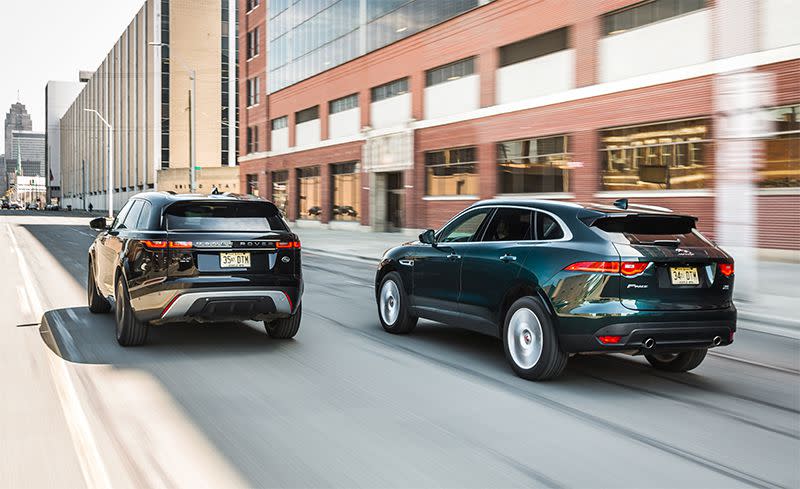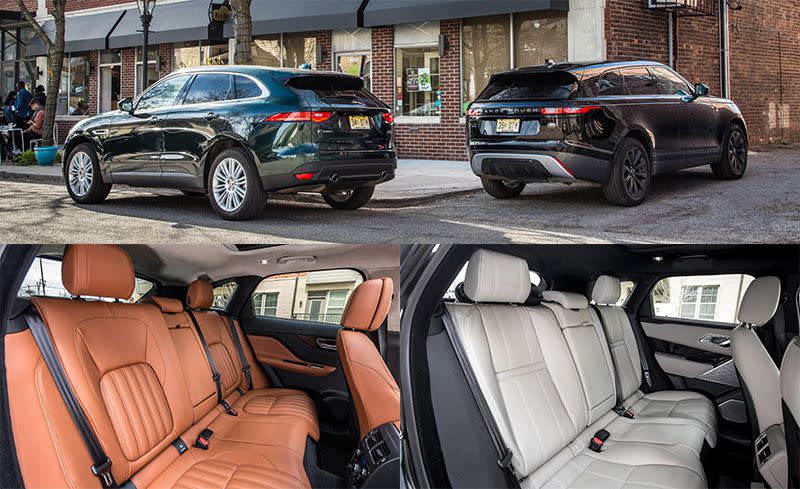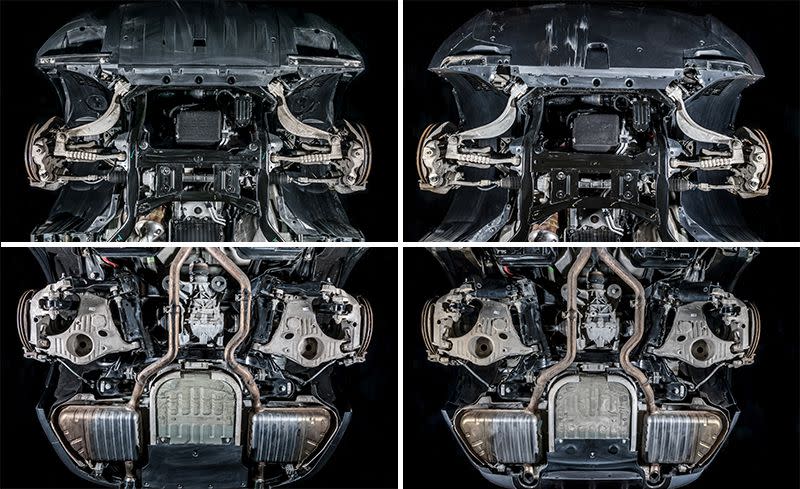Jaguar F-Pace vs. Range Rover Velar: Brothers in Arms

From the July 2018 issue
It won’t surprise you to learn that we here at C/D regularly disagree with one another. It’s often about trivial matters such as how long a Geo Metro can run without oil in its crankcase (we’ll settle that argument soon). Occasionally, we squabble over more pressing issues, like whether or not the cost of executive editor Jared Gall’s Steel Trap deodorant will increase with the hike in Chinese trade tariffs. But in the matter of the Jaguar F-Pace versus the Land Rover Range Rover Velar, we reached a rarely achieved consensus: The Jag wins this showdown of platform-mates because it’s more enjoyable to drive every day.
This alphanumeric soup of mini comparison tests pits Jaguar’s F-Pace 30t Portfolio LE against Land Rover’s Range Rover Velar P250 R-Dynamic SE. Though you’d not gather it from their names, both use the company’s base powerplant, a turbocharged 2.0-liter inline-four. The Jag’s 30t designation means its version of JLR’s Ingenium engine cranks out 296 horsepower. But because America loves choices, Jag also has an F-Pace 25t with the same 247-hp mill found in the Velar we tested. We chose to bring the 296-hp Jaguar to meet the 247-hp Land Rover because their prices aligned best, and because the Velar offers only the lower-output version of the gas four. Further complicating the powertrain options are JLR’s 180-hp four-cylinder diesel and 380-hp supercharged 3.0-liter V-6, which are available in both utes.
To judge from the spec sheets, these are very similar SUVs. Both are built on JLR’s aluminum-intensive D7a platform. Both come standard with eight-speed automatic transmissions and all-wheel drive, ride on 113.1-inch wheelbases, and use the same multilink front and rear suspensions supported by coil springs. But we don’t judge from the spec sheets. We judge on the road and at the test track, and it’s in those places that the Jaguar’s engine and chassis do much of the convincing. Its power advantage, thanks to a ball-bearing turbo with a bigger compressor housing and 5.8 psi more boost, yields a 1.2-second-quicker zero-to-60-mph run (6.2 versus 7.4 seconds). It also carries a 1.0-second advantage through the quarter-mile. It’s a power difference that matters not just when the ute is driven with purpose but also in daily utility. Most telling is the F-Pace’s 2.0-second lead (7.1 versus 9.1 seconds) in our 5-to-60-mph rolling-start test, where its edge in flexibility translates into a more usable real-world SUV. Need to squeeze into a hole in traffic or punch around a couple of slow movers on a two-lane? The Jaguar is there. The F-Pace’s pleasant, if mild, growl, which doesn’t give it away as a four-cylinder, won’t even wake your mother-in-law.
The F-Pace’s dynamic superiority extends into every input at its wheel, which turns a variable-ratio steering rack with a marginally quicker overall ratio than the Rover’s. There’s an unvarnished honesty in its steering that’s not present in the Velar’s helm. Not that the Rover isn’t capable on the road-all its controls perform their duties resolutely but without the Jag’s eagerness. Driven aggressively, the Rover never lost the Jag’s tail on our 10Best loop. But the F-Pace is easily the better communicator of the road’s condition and the available grip. It supplies a complete report, telegraphing undulations and bumps into the driver’s hands. And though that busyness doesn’t always befit a luxury SUV, it clearly spells out the F-Pace’s limits. You can probably guess that the Rover’s ride is the more comfortable of the two. Both sport-utilities wear all-season rubber sized 255/50R-20, but the F-Pace’s Goodyears help give it a slight edge over the Velar’s Pirellis on the skidpad, where it circled at 0.85 g to the Rover’s 0.84 g.
Brake feel and response on the road are a wash, but the Velar exhibited moderate fade at the track, where it also required an additional seven feet to stop from 70 mph compared with the Jag. As it weighs only 60 pounds more than the 4332-pound F-Pace, the Velar’s Pirelli tires are the likely culprits.
Stiffer spring and base damping rates are the Jag’s allies on the road, but with four driving modes to the Velar’s six-three of which are off-road specific-and with a half inch less front-suspension travel, the F-Pace lacks the Velar’s dirt-going latitude. Air springs, which adjust ride height and improve water-fording depth, are a Velar feature when you opt for the V-6, as is an automatic-locking rear differential. So if you’re that exceptionally rare crossover buyer with a desire to befoul your luxury vehicle, the Velar is your huckleberry.
Inside, the Rover is a pioneering starship to the Jag’s aging F-14. Its entire interior treatment is more elegant. Its materials are finer, its shapes more polished, its style more modern. A big part of that style, however, stems from its reliance on dual touchscreens, which smooth and sanitize its surfaces by freeing them of buttons. And because there are no buttons, many secondary controls are buried in the menus and submenus. Improving the situation somewhat are three knobs managing volume, temperature, and drive mode. The F-Pace uses real buttons to toggle between drive modes and to operate the ventilation system. The result is that, on balance, its controls are more quickly found, more intuitive, and easier to use than the Velar’s.
Up front, the Jag’s seat bottoms are well contoured and provide more cushion without posing any competition to the fine folks at Barcalounger. Three across in the back seat is no fun in either, but it’s a contest the Velar wins by having more headroom and a greater sense of airiness. It also has six more cubic feet of cargo space than the F-Pace when its rear seats are folded flat. Both SUVs’ rear seatbacks provide 40/20/40 split folding.
As noted earlier, the Jaguar doesn’t win this comparo on the spec sheet. It wins largely on subjective matters, the smallest nuances of character that coalesce to reveal a more engaging SUV. It has driverly ambition. It encourages hustling, while the Rover merely tolerates it. That it’s quicker and has an as-tested price about $3000 less than the Velar’s simply seals the deal.
2. Land Rover Range Rover Velar
[+] Starship controls, stunning interior, more capable off-road.
[-] Starship controls, less engaging on-road.
[=] A very fine luxury crossover with a side of off-road capability.
1. Jaguar F-Pace
[+] Comfortable at speed, quick enough, playful.
[-] Busier ride, smaller back seat.
[=] The one we’d prefer to drive home.
You Might Also Like

 Yahoo Autos
Yahoo Autos 




